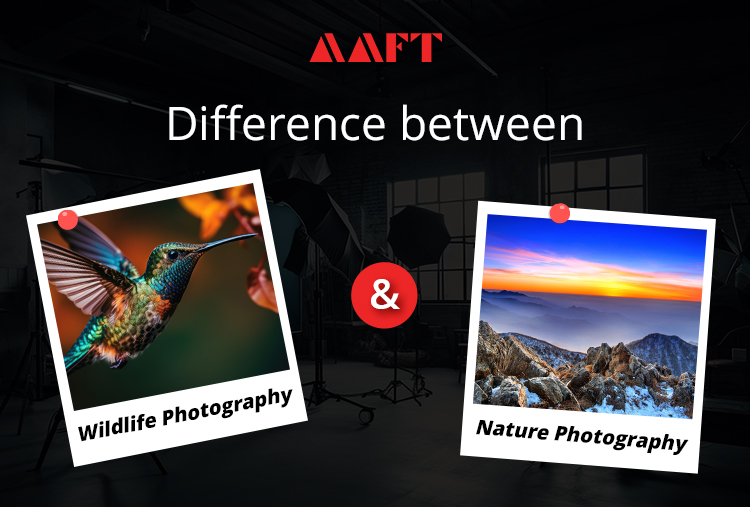Difference between Wildlife Photography and Nature Photography
Well, photography is the art of capturing mesmerizing images of nature and the world. Not just that, but capturing moments, storytelling of moments, and whatnot? In the realm of nature photography, two categories pop up: nature photography and wildlife photography. Why are there only two of them? Because there are no others. Alright, it is because when we click on nature, we either capture wild animals or nature’s beautiful assets like trees, leaves, branches, or pebbles in the river; this covers the whole of nature. Through this blog, we’ll learn more about nature photography’s two sections, i.e., wildlife photography and nature photography. Let’s deep-dive into this blog and move forward.
What is Nature Photography
It is a type of photography that covers nature and its elements with detailing beauty, and the essence of natural elements. Again, this covers a wide range of subjects, like mountains, trees, plants, flowers, seascapes, and other elements in nature. Nature photographers often get appreciated for showcasing their nature photography pieces and telling stories of nature. It is a way to show how beautiful nature is. Nature photographers use various techniques to present more dynamic and professional images; they experiment with lights, compositions, and different perspectives to portray emotions. What you can do is grab your professional camera with a lens kit and go to some remote area. You can also start near your home, like in parks or any area filled with trees. What are you waiting for? Start practising today.
A Photographer’s Relationship with Lights
What is Wildlife Photography?
On the other hand, wildlife photography is another specialized aspect of nature photography. Wildlife photographers are the term people have heard most of the time in the realm of photography. Wildlife photographers focus on capturing wildlife photos of a variety of animals, mammals, and insects. So, what do wildlife photographers try to achieve during their photography? The behaviour of animals, beauty, and emotions. Sometimes, lucky photographers get the best shot at the right time, but it generally takes a lot of time to capture the moment of the depiction of emotions. A wildlife photographer should be very calm and know the demand for patience during wildlife photography. Many wildlife photographers learn the technique of camouflage. Camouflage is the technique by which you can disguise yourself or your appearance to blend in with your surroundings. This technique does not startle the animal and lets one get a dynamic shot, as per the requirement. Wildlife photographers generally go to wildlife environments where there is a presence of wildlife, such as reserved sanctuaries or national parks.
Key Differences Between Wildlife Photography and Nature Photography
Wildlife Photography:
- Focus: Primarily focuses on capturing images of animals in their natural habitats.
- Subjects: Includes mammals, birds, reptiles, insects, and other wildlife species.
- Behavioral Study: Often involves documenting the behavior, interactions, and life cycles of animals.
- Challenges: Requires patience and stealth to avoid disturbing the animals, and often demands long waits for the perfect shot.
- Equipment: Typically involves the use of telephoto lenses to capture distant subjects without intrusion.
- Ethics: Emphasizes ethical practices to ensure minimal impact on wildlife and their habitats.
- Timing: Best times for photography are often early morning or late afternoon when animals are most active.
- Locations: Commonly takes place in national parks, wildlife reserves, and other areas with abundant animal populations.
Do you want free career counseling?
Ignite Your Ambitions- Seize the Opportunity for a Free Career Counseling Session.
- 30+ Years in Education
- 250+ Faculties
- 30K+ Alumni Network
- 10th in World Ranking
- 1000+ Celebrity
- 120+ Countries Students Enrolled
Difference Between Full-Frame and Crop-Sensor
Nature Photography:
- Focus: Encompasses a broader range of subjects, including landscapes, plants, water bodies, weather phenomena, and geological formations.
- Subjects: Can include forests, mountains, rivers, flowers, trees, sunsets, and more.
- Aesthetic: Often aims to capture the beauty and essence of natural scenes, emphasizing composition, light, and color.
- Versatility: More flexible in subject matter and can be practiced almost anywhere, from backyards to remote wilderness areas.
- Equipment: Wide-angle lenses and macro lenses are commonly used to capture expansive vistas or close-up details.
- Creativity: Allows for greater creative freedom in terms of framing, composition, and post-processing.
- Timing: Golden hours (sunrise and sunset) are ideal for capturing dramatic lighting and colors.
- Locations: Can include a wide variety of settings, from serene gardens to rugged mountains, and even urban parks.
Nature and wildlife Photography Tips For Beginners
Plan accordingly
A good pair of hiking shoes or boots can make a big difference. Make sure that you are dressed appropriately for the weather. Layering is the best way to ensure that you remain warm yet can easily cool down if need be. Ensure safety. Check rules and regulations of that place where you are going to shoot. Either bring a companion or inform another person about your destination.
Get familiar with your camera’s settings
For high-quality images, capture them in RAW. Set the limit of your ISO at minimum in order to allow more light into your picture. However, do not forget about the need to adjust your shutter speed accordingly. Do it at home before going out there!
Book Now →
Five Tips To Improve Your Photography Skills
Bring the right equipment
Using a tripod is recommended unless you’re aiming for blur because you’ve got incredibly steady hands. In case you don’t have one, just use the ground, rock or tree branch in helping stabilize your camera while taking shots then if these are lacking hold it close by keeping arms tight against yourself thereby achieving as much stabilization as possible. It’s also advisable to avoid sun spots by having an appropriate hood on your lens during sunny days.
You don’t need a fancy Nikon or Canon to shoot
It may capture some amazing pictures but camera phones can perform just as well if a DSLR is out of reach because your iPhone or Android phone can still do some amazing things with technology advancing all the time. Your device has great potential that you can only bring out when you know how to operate it well!
Do you want free career counseling?
Ignite Your Ambitions- Seize the Opportunity for a Free Career Counseling Session.Use the rule of thirds
The rule of thirds is an essential part of photography. Think of the picture as being cut into 9 equal sections with two equally spaced lines running across vertically and horizontally. This is where your viewer’s eye would normally end up since that is where the lines intersect. If you place any person on these lines or focus them within any of these squares, then you will create dynamic images.
Don’t get too close
Animals might easily get frightened. In order to photograph wildlife, you shouldn’t scare your subject by maintaining an appropriate distance.
What is Aerial photography? Types and Career Path
Get a new perspective
A new perspective on your subject can lead to more engaging photographs. Climb higher, go down lower, or try out various framing techniques.
Patience is key
Instead of disturbing animals where they live, you may have to wait it out in order to take a photograph. A little more time spent waiting would sometimes pay off big time. Do not feel disappointed! Investigate the animal or do some reading before going to familiarize yourself with how it behaves.
Have fun!
It is invigorating when you get some fresh air. Even if you don’t nail the specific shot you were going for, just savor that particular moment.
Don’t give up!
Take into account that patience is crucial. There are times when it can be so daunting to get the right wildlife picture or that moment in nature. As you keep going and keep learning, however, your photos will start to show these changes. All along, I know that whenever I am out there, I am still learning something.
Things to know as a Professional Photographer
Conclusion
In conclusion, we can say that both aspects of nature photography share the same goal of depicting the beauty of nature. However, nature photography focuses on the elements of nature, as we discussed in the section above, and wildlife photography focuses on capturing the beauty, emotions, and behaviour of wildlife animals, from large mammals to small insects. This was all about the differences between wildlife photography and nature photography.

AAFT has been providing the world with limitless creativity and expression since 1993! Through a dynamic and industry-driven curriculum, AAFT provides engaging and captivating articles to persuasive blogs and empowers its readers to explore diverse avenues of creative media education-related content.








